Shear-Induced Graphitization in Tongyuanpu Shear Zone, Liaodong Peninsula of Eastern China: Insights from Graphite Occurrences, Nanostructures and Carbon Sources
Abstract
1. Introduction
2. Geological Background and Deformation Characteristics of Shear Zones
3. Experimental Methods
3.1. Electron Backscatter Diffraction
3.2. Micro-Laser Raman Spectroscopy
3.3. X-Ray Diffraction
3.4. High-Resolution Transmission Electron Microscopy
3.5. Total Organic Carbon
3.6. Carbon Isotope
4. Results
4.1. Microscopic Deformation and Lattice Preferred Orientation Characteristics of Graphitic Tectonites
4.1.1. Microscopic Deformation Characteristics
4.1.2. EBSD Lattice Preferred Orientation Characteristics
4.2. TOC Contents and Characteristics of Carbon Nanostructures
4.2.1. TOC Contents
4.2.2. XRD Spectral Characteristics
4.2.3. Raman Spectral Characteristics and Peak Metamorphic Temperature
4.2.4. HRTEM Characteristics
4.3. Carbon Isotopic Composition
5. Discussion and Conclusions
5.1. The Influence of Deformation–Metamorphism on Graphitization
5.2. The Influence of Deformation Mechanisms on Graphitization
Author Contributions
Funding
Data Availability Statement
Acknowledgments
Conflicts of Interest
References
- Hou, Q.L. Advanced Structural Geology (Volume 3: Specialized Knowledge and Practice); Science Press: Beijing, China, 2020; pp. 1–338. [Google Scholar]
- Liu, J.L. Strain localization and strain weakening in the continental middle crust. Acta Petrol. Sin. 2017, 33, 1653–1666. [Google Scholar]
- Passchier, C.W.; Trouw, R.A.J. Microtectonics, 2nd ed.; Springer: Berlin, Germany, 2005; pp. 1–366. [Google Scholar]
- Stüwe, K. Geodynamics of the Lithosphere; Springer: Berlin/Heidelberg, Germany, 2007. [Google Scholar]
- Kuo, L.W.; Felice, F.D.; Spagnuolo, E.; Toro, G.D.; Song, S.R.; Aretusini, S.; Li, H.B.; Suppe, J.; Si, J.L.; Wen, C.Y. Fault gouge graphitization as evidence of past seismic slip. Geology 2017, 45, 979–982. [Google Scholar] [CrossRef]
- Kuo, L.W.; Li, H.B.; Smith, S.A.F.; Di Toro, G.; Suppe, J.; Song, S.R.; Nielsen, S.; Sheu, H.S.; Si, J. Gouge graphitization and dynamic fault weakening during the 2008 Mw 7.9 Wenchuan earthquake. Geology 2014, 42, 47–50. [Google Scholar] [CrossRef]
- Liu, J.; Li, H.B.; Si, J.L.; Liu, D.L.; Wang, H. Origin, formation and tectonic implications of carbonaceous material in the Wenchuan earthquake fault zone. Acta Geol. Sin. 2016, 90, 2567–2581. [Google Scholar]
- Hou, Q.L.; Li, J.L.; Sun, S.; Li, P.J. Discovery and mechanism discussion of supergene micro-ductile shear zone. Chin. Sci. Bull. 1995, 40, 824–827. [Google Scholar]
- Oohashi, K.; Hirose, T.; Kobayashi, K.; Shimamoto, T. The occurrence of graphite-bearing fault rocks in the Atotsugawa fault system, Japan: Origins and implications for fault creep. J. Struct. Geol. 2012, 38, 39–50. [Google Scholar] [CrossRef]
- Lyu, M.X.; Cao, S.Y.; Neubauer, F.; Li, J.Y.; Cheng, X.M. Deformation fabrics and strain localization mechanisms in graphitic carbon-bearing rocks from the Ailaoshan-Red River strike-slip fault zone. J. Struct. Geol. 2020, 140, 104150. [Google Scholar] [CrossRef]
- Cao, S.Y.; Neubauer, F. Graphitic material in fault zones: Implications for fault strength and carbon cycle. Earth Sci. Rev. 2019, 194, 109–124. [Google Scholar] [CrossRef]
- Oohashi, K.; Hirose, T.; Shimamoto, T. Graphite as a lubricating agent in fault zones: An insight from low- to high-velocity friction experiments on a mixed graphite-quartz gouge. J. Geophys. Res. Solid Earth 2013, 118, 2067–2084. [Google Scholar] [CrossRef]
- Chen, J.Y.; Chen, J.Y.; Yao, L. Frictional strength, electrical conductivity, and microstructure of calcite-graphite mixtures sheared at a subseismic slip rate. Tectonophys 2023, 868, 230085. [Google Scholar] [CrossRef]
- Li, H.B.; Xu, Z.Q.; Ma, S.L.; Zhao, J.M. Research progress on faulting and dynamic processes of the 2008 Wenchuan and 2017 Jiuzhaigou earthquakes: To commemorate the 10th anniversary of the Wenchuan earthquake. Chin. J. Geophys. 2018, 61, 1653–1665. [Google Scholar]
- Rutter, E.H.; Hackston, A.J.; Yeatman, E.; Brodie, K.H.; Mecklenburgh, J.; May, S.E. Reduction of friction on geological faults by weak-phase smearing. J. Struct. Geol. 2013, 51, 52–60. [Google Scholar] [CrossRef]
- Luque, F.J.; Ortega, L.; Barrenechea, J.F.; Millward, D.; Beyssac, O.; Huizenga, J.M. Deposition of highly crystalline graphite from moderate-temperature fluids. Geology 2009, 37, 275–278. [Google Scholar] [CrossRef]
- Binu-Lal, S.S.; Kehelpannala, K.V.W.; Satish-Kumar, M.; Wada, H. Multistage graphite precipitation through protracted fluid flow in sheared metagranitoid, Digana, Sri Lanka: Evidence from stable isotopes. Chem. Geol. 2003, 197, 253–270. [Google Scholar] [CrossRef]
- Oohashi, K.; Hirose, T.; Shimamoto, T. Shear-induced graphitization of carbonaceous materials during seismic fault motion: Experiments and possible implications for fault mechanics. J. Struct. Geol. 2011, 33, 1122–1134. [Google Scholar] [CrossRef]
- Galvez, M.E.; Beyssac, O.; Martinez, I.; Benzerara, K.; Chaduteau, C.; Malvoisin, B.; Malavieille, J. Graphite formation by carbonate reduction during subduction. Nat. Geosci. 2013, 6, 473–477. [Google Scholar] [CrossRef]
- Cheng, N.N.; Shi, M.Y.; Hou, Q.L.; Wang, J.; Pan, J.N. The impact of tectonic stress chemistry on mineralization processes: A review. Solid Earth Sci. 2022, 7, 151–166. [Google Scholar] [CrossRef]
- Tao, R.B.; Zhang, L.F.; Tian, M.; Zhu, J.J.; Liu, X.; Liu, J.Z.; Höfer, H.E.; Stagno, V.; Fei, Y.W. Formation of abiotic hydrocarbon from reduction of carbonate in subduction zones: Constraints from petrological observation and experimental simulation. Geochim. Cosmochim. Acta 2018, 239, 390–408. [Google Scholar] [CrossRef]
- Liang, C.Y.; Liu, Y.J.; Zheng, C.Q.; Li, W.M.; Neubauer, F.; Zhang, Q. Macro-and microstructural, textural fabrics and deformation mechanism of calcite mylonites from Xar Moron-Changchun dextral shear zone, northeast China. Acta Geol. Sin. Engl. Ed. 2019, 93, 1477–1499. [Google Scholar] [CrossRef]
- Delle Piane, C.; Piazolo, S.; Timms, N.E.; Luzin, V.; Saumders, M.; Bourdet, J.; Giwelli, A.; Clennel, M.B.; Kong, C.; Rickard, W.D.A.; et al. Generation of amorphous carbon and crystallographic texture during low-temperature subseismic slip in calcite fault gouge. Geology 2018, 46, 163–166. [Google Scholar] [CrossRef]
- Oohashi, K.; Han, R.; Hirose, T.; Shimamoto, T.; Omura, K.; Matsuda, T. Carbon-forming reactions under a reducing atmosphere during seismic fault slip. Geology 2014, 42, 787–790. [Google Scholar] [CrossRef]
- Hou, Q.L.; Lu, L.X.; Cheng, N.N. Some thoughts on challenges and opportunities in structural geology and tectonics. Acta Petrol. Sin. 2021, 37, 2271–2275. [Google Scholar]
- Li, J.B.; Ma, Y.M.; Cheng, N.N.; Shi, M.Y.; Pan, J.N. Research on the tectonic stress control mechanisms of graphitization in carbonate rocks. Carbonate Evaporite 2025, 40, 94. [Google Scholar] [CrossRef]
- Bureau of Geology and Mineral Resources of Liaoning Province. Regional Geology of the Liaoning Province; Geological Publishing House: Beijing, China, 2014; pp. 1–1433. [Google Scholar]
- Shi, Y.C.; Cui, W.L.; Huang, G.Y.; Guo, J.H.; Zou, L.; Huang, M.Y. Cooling and exhumation of the Jiao-Liao-Ji Belt: Evidence from multi-isotopic systems in-situ geochronology. Precambrian Res. 2025, 417, 107672. [Google Scholar] [CrossRef]
- Zhao, G.; Sun, M.; Wilde, S.A.; Li, S.Z. Late Archean to Paleoproterozoic evolution of the North China Craton: Key issues revisited. Precambrian Res. 2005, 136, 177–202. [Google Scholar] [CrossRef]
- Zhai, M.G.; Guo, J.H.; Liu, W. Neoarchean to Paleoproterozoic continental evolution and tectonic history of the North China Craton: A review. J. Asian Earth Sci. 2005, 24, 547–561. [Google Scholar] [CrossRef]
- Wan, Y.S.; Dong, C.Y.; Xie, H.Q.; Wilde, S.A.; Liu, S.J.; Li, P.C.; Ma, M.Z.; Li, Y.; Wang, Y.Q.; Wang, K.L.; et al. Hadean to early Mesoarchean rocks and zircons in the North China Craton: A review. Earth Sci. Rev. 2023, 243, 104489. [Google Scholar] [CrossRef]
- Qiu, L.; Kong, R.Y.; Yan, D.P.; Wells, M.L.; Wang, A.; Sun, W.; Yang, W.X.; Han, Y.G.; Li, C.; Zhang, Y.; et al. The Zhayao tectonic window of the Jurassic Yuantai thrust system in Liaodong Peninsula, NE China: Geometry, kinematics and tectonic implications. J. Asian Earth Sci. 2018, 164, 58–71. [Google Scholar] [CrossRef]
- Yan, D.P.; Kong, R.Y.; Dong, X.; Qiu, L.; Liu, H. Late Jurassic-Early Cretaceous tectonic switching in Liaodong Peninsula of the North China Craton and the implications for gold mineralisation. Sci. China Earth Sci. 2021, 64, 1537–1556. [Google Scholar] [CrossRef]
- Kong, R.Y.; Yan, D.P.; Qiu, L.; Wells, M.L.; Wang, A.; Dong, X.; Mu, H.; Gong, L.X. Early Cretaceous tectonic transition and SW–ward basin migration in northern Liaodong Peninsula, NE China: Sedimentary, structural, and geochronological constraints. Geol. J. 2020, 55, 5681–5702. [Google Scholar] [CrossRef]
- Yang, J.H.; Xu, L.; Sun, J.F.; Zeng, Q.; Zhao, Y.N.; Wang, H.; Zhu, Y.S. Geodynamics of decratonization and related magmatism and mineralization in the North China Craton. Sci. China Earth Sci. 2021, 64, 1409–1427. [Google Scholar] [CrossRef]
- Lin, W.; Wang, Q.C.; Wang, J.; Wang, F.; Chu, Y.; Chen, K. Late Mesozoic extensional tectonics of the Liaodong Peninsula massif: Response of crust to continental lithosphere destruction of the North China Craton. Sci. China Earth Sci. 2011, 54, 843–857. [Google Scholar] [CrossRef]
- Zhu, R.X.; Yang, J.H.; Wang, G.W.; Zeng, Q.D.; Xue, G.Q.; Xu, T.; Li, X.H.; Zhang, P.; Lei, D.; Zhu, G. The genesis and resource potential of gold deposits in the Liaodong Peninsula. Sci. China Earth Sci. 2024, 67, 657–672. [Google Scholar] [CrossRef]
- Cheng, N.N.; Shi, M.Y.; Hou, Q.L.; Pan, J.N.; Han, Y.Z. Application of Raman spectroscopy in characterization of coal macromolecular structure. J. China Coal Soc. 2023, 48, 1311–1324. [Google Scholar]
- Rahl, J.M.; Anderson, K.M.; Brandon, M.T.; Fassoulas, C. Raman spectroscopic carbonaceous material thermometry of low–grade metamorphic rocks: Ralibration and application to tectonic exhumation in Crete, Greece. Earth Planet. Sci. Lett. 2005, 240, 339–354. [Google Scholar] [CrossRef]
- Jiang, G.Z.; Li, Y.K.; Wang, A.J.; Yang, X.A.; Yang, B.; Ma, L. Genetic features of Dawudian graphite deposit in Urad Middle Banner, Inner Mongolia. Earth Sci. Front. China Univ. Geosci. Peaking Univ. 2017, 24, 306–316. [Google Scholar]
- Cao, S.Y.; Lyu, M.X. Quantitative constraint of tectono-thermal process by deformed graphite and its rheological weakening significance. Acta Geol. Sin. 2022, 96, 3573–3588. [Google Scholar]
- Cao, D.Y.; Wei, Y.C.; Li, Y.; Liu, Z.F.; Li, H.T.; Wang, L.; Wu, G.Q.; Ning, S.Z.; Xu, X. Determination of identification index and construction of classification and classification system of coal measures graphite. J. China Coal Soc. 2021, 46, 1833–1846. [Google Scholar]
- Chen, Y.Y.; Wang, B.; Liu, J.S.; Lu, S.H.; Bryan, C. Advance in laser Raman spectroscopy carbon geothermometer and its application in Earth sciences. Geol. J. China Univ. 2023, 29, 908–923. [Google Scholar]
- Ferrari, A.; Robertson, J. Interpretation of Raman spectra of disordered and amorphous carbon. Phys. Rev. B 2000, 61, 14095–14107. [Google Scholar] [CrossRef]
- Zhang, H.; Nie, B.S.; Hu, F.F.; Zhao, D.; He, H.Y.; Bao, S.; Zhou, H.W.; Li, H.X.; Zhang, R. Thermal properties and in situ Raman structural evolution of different rank coals during argon heating. Therm. Sci. Eng. Prog. 2025, 64, 103812. [Google Scholar] [CrossRef]
- Han, Y.Z.; Wang, J.; Dong, Y.J.; Hou, Q.L.; Pan, J.N. The role of structure defects in the deformation of anthracite and their influence on the macromolecular structure. Fuel 2017, 206, 1–9. [Google Scholar] [CrossRef]
- Li, J.Q.; Qin, Y.; Chen, Y.L.; Song, Y.; Wang, Z.W. HRTEM observation of morphological and structural evolution of aromatic fringes during the transition from coal to graphite. Carbon 2022, 187, 133–144. [Google Scholar] [CrossRef]
- Hu, G.H.; Li, Z.K.; Liu, J.M.; Xiao, C.H.; Zhang, Q.Q.; Liu, F.X.; Wang, W.; Zhang, P. Genetic linkage between carbonaceous materials and Triassic gold deposits in the Liaodong Peninsula, northeastern North China Craton: Insights from Raman spectroscopy and C-O isotope analysis. Ore Geol. Rev. 2022, 150, 105182. [Google Scholar] [CrossRef]
- Zhu, J.J.; Zhang, L.; Yang, Y.H.; Liu, Z.Y. A review of study on genesis of Paleoproterozoic graphite deposits in the North China Craton: Progresses and Questions. Acta Petrol. Sin. 2024, 40, 3257–3280. [Google Scholar] [CrossRef]
- Li, K.Y.; Chen, Y.J.; She, Z.B.; Tang, H.S.; Chen, W.Y. Carbon isotope compositions and geochemical characteristics of the Zhangshe graphite deposit of the Jingshan Group, Jiaobei. Earth Sci. Front. China Univ. Geosci. Peaking Univ. 2018, 25, 19–33. [Google Scholar]
- Hu, H.; Zhang, L.F.; Peng, W.G.; Lan, C.Y.; Liu, Z.C. Formation of graphite in ultrahigh-pressure pelitic schists from the south-western Tianshan: Implication for carbon migratioon and sequestration in subduction zones. Earth Sci. Front. China Univ. Geosci. Peaking Univ. 2024, 31, 282–303. [Google Scholar]
- Luque, F.J.; Crespo-Feo, E.; Barrenechea, J.F.; Ortega, L. Carbon isotopes of graphite: Implications on fluid history. Geosci. Front. 2012, 3, 197–207. [Google Scholar] [CrossRef]
- Zhang, C.; He, X.; Sun, L.; Santosh, M.; Chi, J.; Yu, X.Y.; Li, Z.S.; Meng, Y.X. Graphitization in Paleoproterozoic granulites from the Taihua Complex, North China Craton: Constraints from laser Raman spectroscopy, carbon isotopes and geochronology. Lithos 2023, 454–455, 107266. [Google Scholar] [CrossRef]
- Hou, Q.L.; Zhong, D.L.; Guo, Q.Q. Deformation and metamorphism of Wuliangshan area, western Yunnan. Chin. J. Geol. 2013, 48, 354–361. [Google Scholar]
- Beyssac, O.; Goffé, B.; Petitet, J.P.; Froigneux, E.; Moreau, M.; Rouzaud, J.N. On the characterization of disordered and heterogeneous carbonaceous materials by Raman spectroscopy. Spectrochim. Acta Part A 2003, 59, 2267–2276. [Google Scholar] [CrossRef] [PubMed]
- Huang, B.Y.; Zhang, B.; Zhang, J.J.; Tan, Z.; Zhang, L.; Chen, S.Y.; Li, X.R. Carbon material Raman spectroscopy metamorphic thermometer and its application in reconstruction and evolution of orogenic belt thermal structure. Acta Petrol. Sin. 2020, 36, 526–540. [Google Scholar]
- Ross, J.V.; Bustin, R.M.; Rouzaud, J.N. Graphitization of high rank coals-the role of shear strain: Experimental considerations. Org. Geochem. 1991, 17, 585–596. [Google Scholar] [CrossRef]
- Wilks, K.R.; Mastalerz, M.; Bustin, R.M.; Ross, J.V. The role of shear strain in the graphitization of a high-volatile bituminous and an anthracitic coal. Int. J. Coal Geol. 1993, 22, 247–277. [Google Scholar] [CrossRef]
- Bustin, R.M.; Rouzaud, J.N.; Ross, J.V. Natural graphitization of anthracite: Experimental considerations. Carbon 1995, 33, 679–691. [Google Scholar] [CrossRef]
- Ross, J.V.; Bustin, R.M. Vitrinite anisotropy resulting from simple shear experiments at high temperature and high confining pressure. Int. J. Coal Geol. 1997, 33, 153–168. [Google Scholar] [CrossRef]
- Wilks, K.R.; Mastalerz, M.; Ross, J.V.; Bustin, R.M. The effect of experimental deformation on the graphitization of Pennsylvania anthracite. Int. J. Coal Geol. 1993, 24, 347–369. [Google Scholar] [CrossRef]
- Ma, T.B.; Wang, L.F.; Hu, Y.Z.; Li, X.; Wang, H. A shear localization mechanism for lubricity of amorphous carbon materials. Sci. Rep. 2013, 4, 3662. [Google Scholar] [CrossRef]
- Ma, T.B.; Hu, Y.Z.; Xu, L.; Wang, L.F.; Wang, H. Shear-induced lamellar ordering and interfacial sliding in amorphous carbon films: A superlow friction regime. Chem. Phys. Lett. 2011, 514, 325–329. [Google Scholar] [CrossRef]
- Barzoi, S.C. Shear stress in the graphitization of carbonaceous matter during the low-grade metamorphism from the northern Parang Mountains (South Carpathians)—Implications to graphite geothermometry. Int. J. Coal Geol. 2015, 146, 179–187. [Google Scholar] [CrossRef]
- Krabbendam, M.; Urai, L.J.; Vliet, L.J.V. Grain size stabilization by dispersed graphite in a high-grade quartz mylonite: An example from Naxos (Greece). J. Struct. Geol. 2003, 25, 855–866. [Google Scholar] [CrossRef]

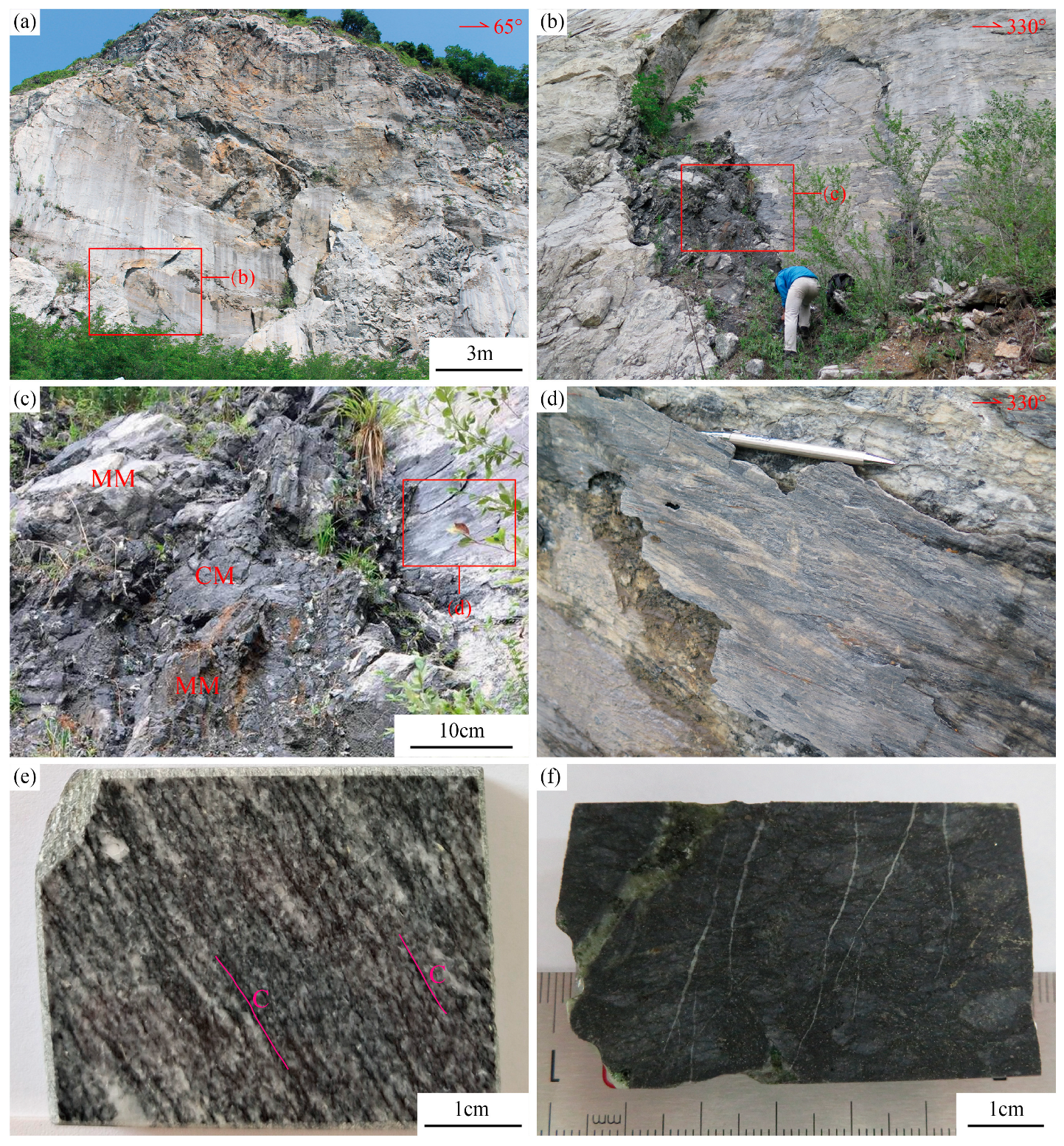
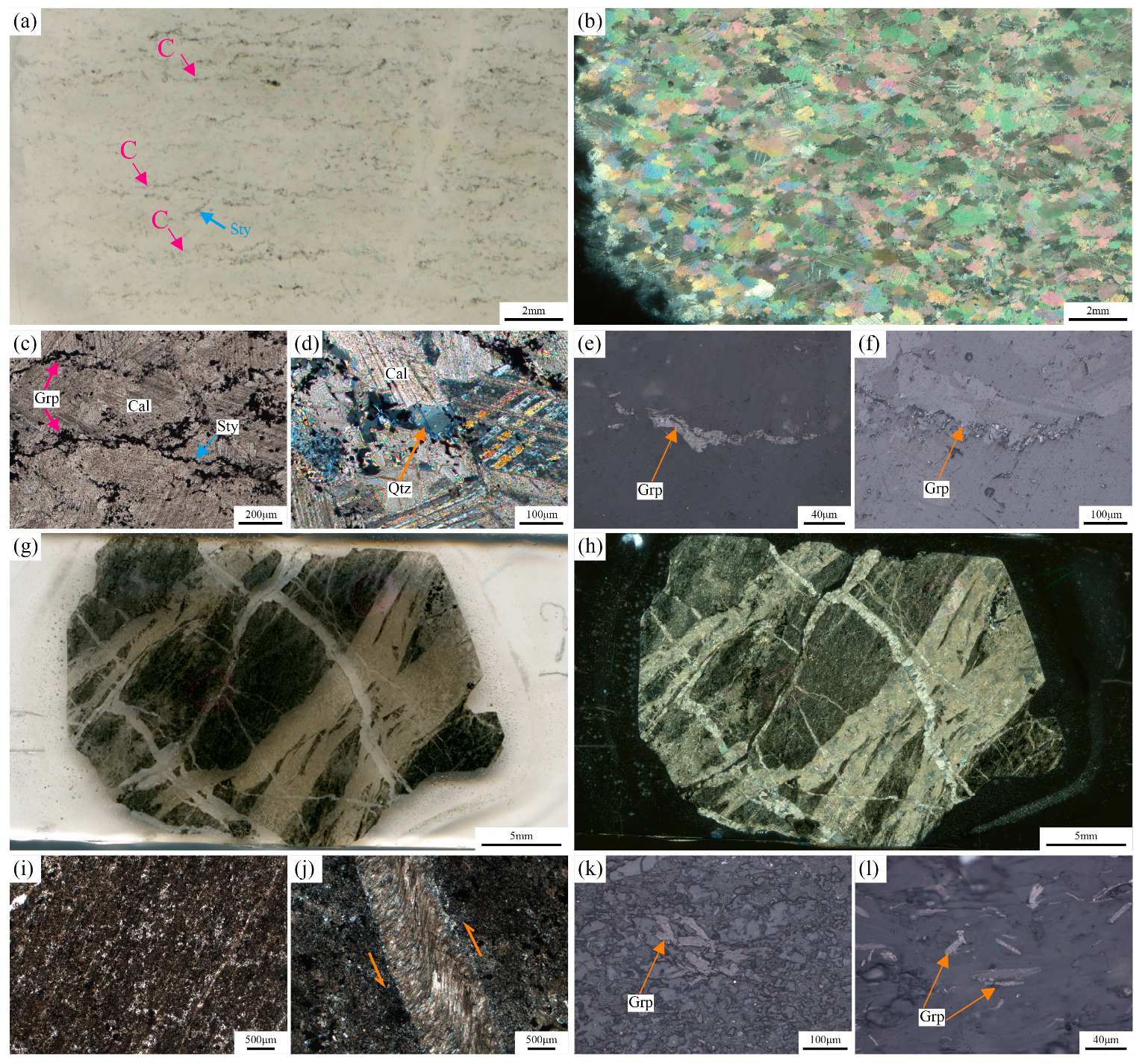
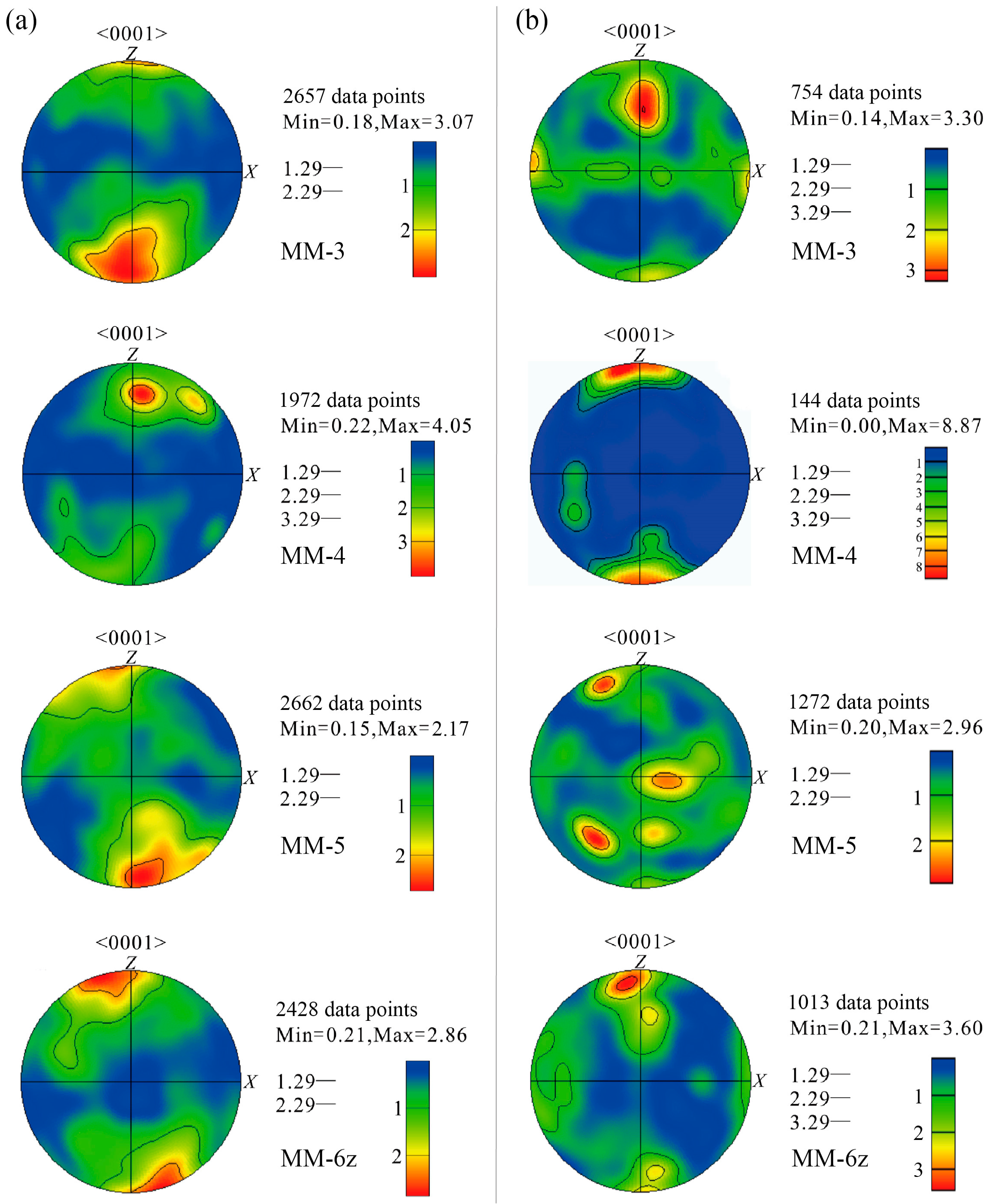
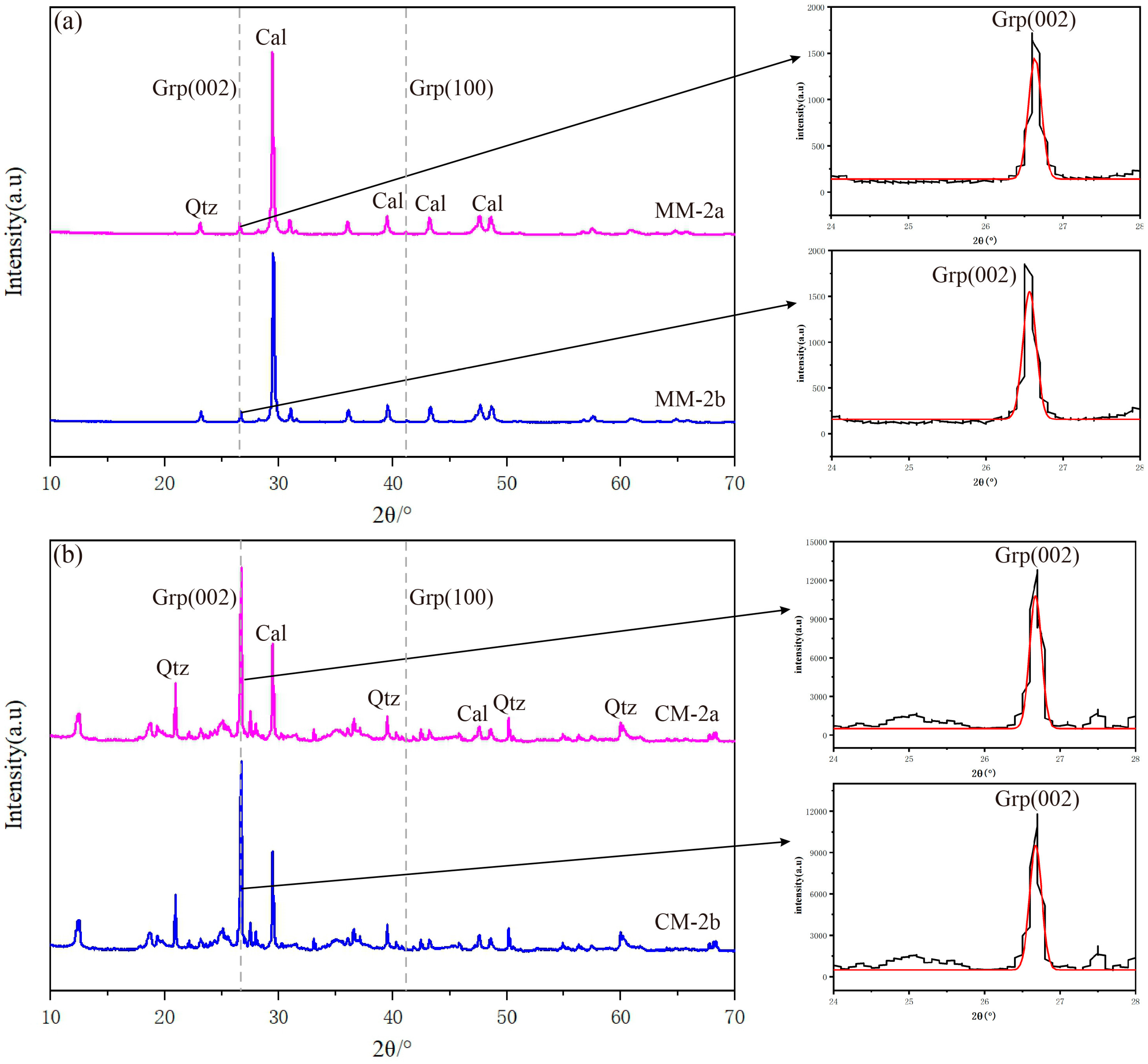
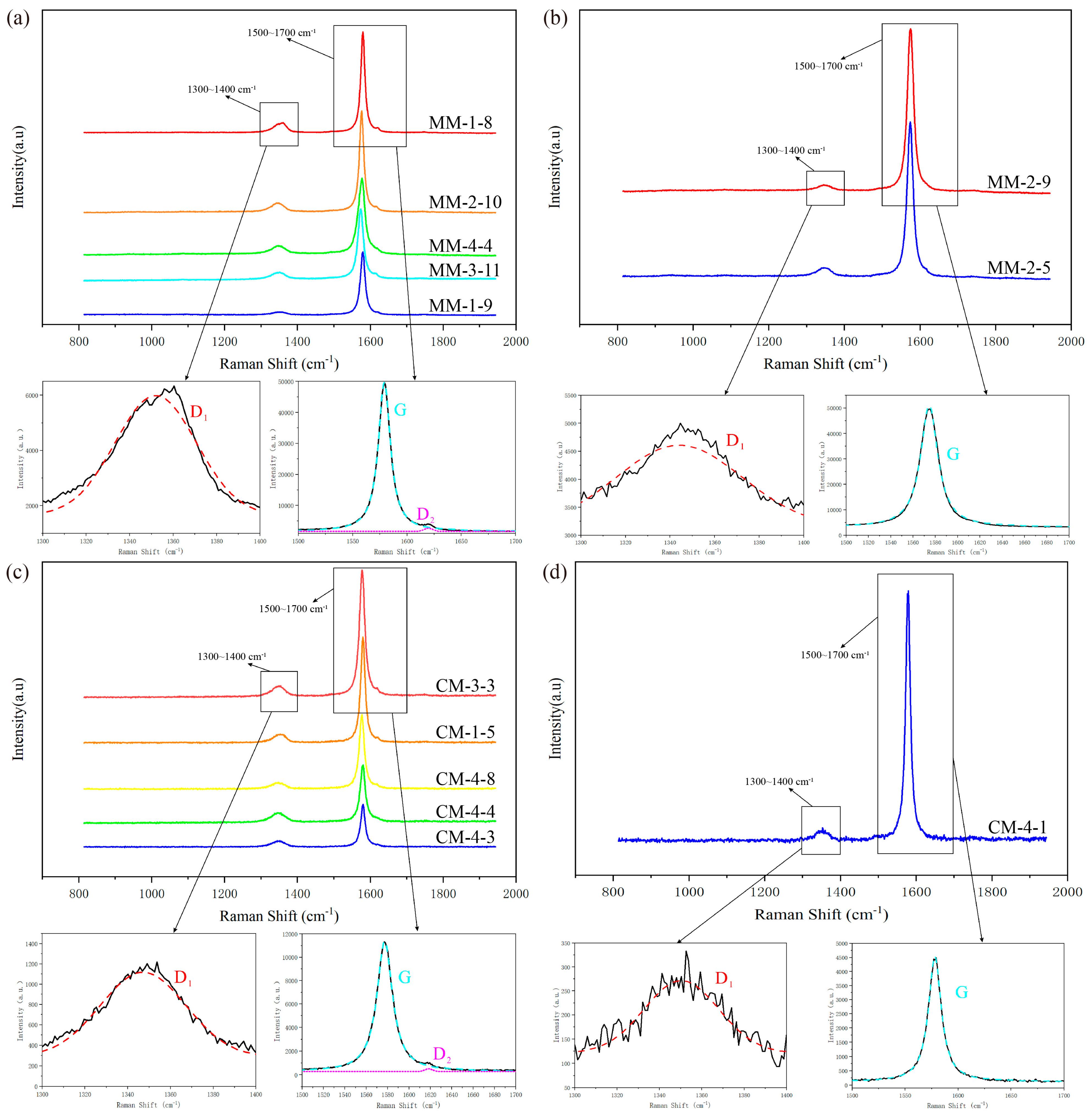

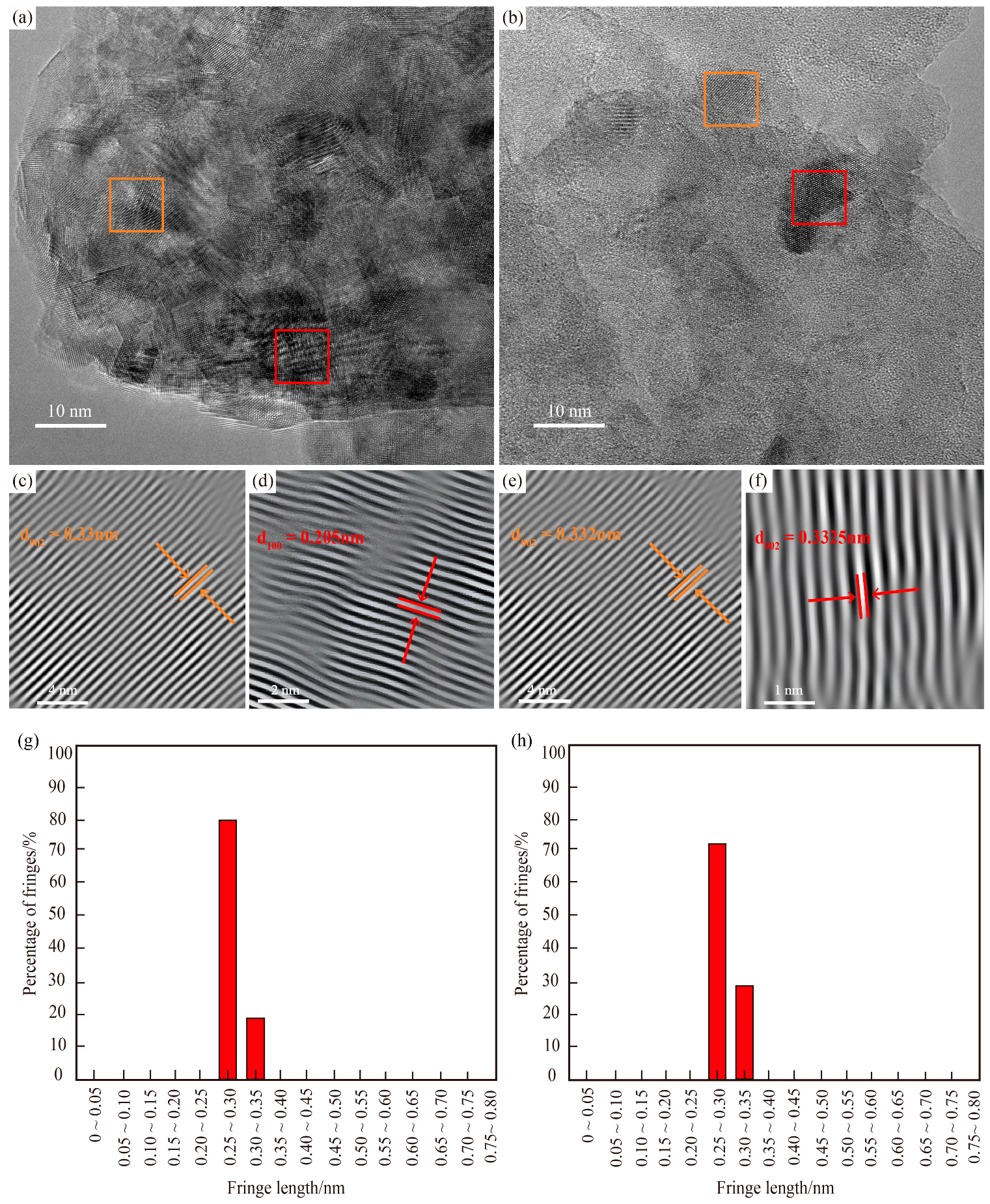

| Samples | TOC Content/wt‰ |
|---|---|
| MM-1 | 8.35 |
| MM-2 | 8.04 |
| CM-1 | 23.74 |
| CM-2 | 23.59 |
| Samples | K | λ | 2θ/° | β002/° | d002 /10−10 m | Lc /10−10 m | DG/% |
|---|---|---|---|---|---|---|---|
| MM-2a | 0.89 | 1.5406 | 26.64 | 0.20 | 3.344 | 403 | 90 |
| MM-2b | 0.89 | 1.5406 | 26.57 | 0.21 | 3.353 | 391 | 85 |
| CM-2a | 0.89 | 1.5406 | 26.67 | 0.19 | 3.339 | 432 | 99 |
| CM-2b | 0.89 | 1.5406 | 26.68 | 0.19 | 3.338 | 425 | 97 |
| Samples | Peak Type | Peak Area | FWHM/cm−1 | Peak Intensity/cm−1 | Peak Position/cm−1 | R1 | R2 | TMP/°C | Vibration Type |
|---|---|---|---|---|---|---|---|---|---|
| MM18 | D1 | 203,788.83 | 44.14 | 4337.02 | 1351.96 | 0.09 | 0.17 | 588 | G –in-plane E2g bond-stretching motion of sp2 carbons [44,45]. D1 and D2 –A 1g symmetrical vibration motion of sp2 carbons [44,45,46]. |
| G | 1,007,350.99 | 13.47 | 48,012.90 | 1579.14 | |||||
| D2 | 10,166.19 | 9.37 | 1018.88 | 1619.70 | |||||
| MM19 | D1 | 59,388.36 | 44.48 | 1254.21 | 1348.92 | 0.04 | 0.08 | 669 | |
| G | 713,173.12 | 15.23 | 30,115.98 | 1578.85 | |||||
| D2 | 2211.27 | 5.94 | 349.80 | 1620.52 | |||||
| MM25 | D1 | 136,136.60 | 54.22 | 2358.65 | 1344.64 | 0.05 | 0.10 | 652 | |
| G | 1,283,158.31 | 18.53 | 44,609.54 | 1573.58 | |||||
| D2 | — | — | — | — | |||||
| MM29 | D1 | 103,689.01 | 66.79 | 1458.36 | 1344.12 | 0.03 | 0.07 | 673 | |
| G | 1,398,986.07 | 18.83 | 47,868.37 | 1574.47 | |||||
| D2 | — | — | — | — | |||||
| MM210 | D1 | 206,820.96 | 49.16 | 3952.65 | 1344.40 | 0.08 | 0.16 | 594 | |
| G | 1,080,394.53 | 14.52 | 47,803.75 | 1575.74 | |||||
| D2 | 14,482.68 | 13.41 | 1014.62 | 1615.55 | |||||
| MM311 | D1 | 173,448.31 | 53.47 | 3047.67 | 1346.90 | 0.09 | 0.15 | 606 | |
| G | 962,372.91 | 18.59 | 33,349.44 | 1573.12 | |||||
| D2 | 20,560.11 | 16.88 | 1144.17 | 1614.12 | |||||
| MM44 | D1 | 232,729.25 | 61.45 | 3558.03 | 1346.27 | 0.10 | 0.16 | 599 | |
| G | 1,222,144.28 | 22.06 | 35,775.14 | 1575.72 | |||||
| D2 | 8841.40 | 13.41 | 619.32 | 1616.42 | |||||
| CM15 | D1 | 31,510.07 | 43.04 | 687.83 | 1350.43 | 0.07 | 0.13 | 622 | |
| G | 209351.83 | 14.67 | 9172.57 | 1579.40 | |||||
| D2 | 1267.16 | 7.45 | 159.74 | 1619.87 | |||||
| CM33 | D1 | 41,628.39 | 47.11 | 830.18 | 1347.14 | 0.07 | 0.12 | 632 | |
| G | 301,693.34 | 17.51 | 11,094.52 | 1577.26 | |||||
| D2 | 2085.99 | 8.55 | 229.30 | 1618.38 | |||||
| CM41 | D1 | 6600.58 | 41.34 | 149.99 | 1350.38 | 0.03 | 0.06 | 682 | |
| G | 100,000.76 | 14.63 | 4395.12 | 1578.05 | |||||
| D2 | — | — | — | — | |||||
| CM43 | D1 | 23,518.86 | 46.47 | 475.42 | 1346.88 | 0.13 | 0.21 | 549 | |
| G | 84,423.01 | 14.83 | 3659.58 | 1579.39 | |||||
| D2 | 1797.93 | 22.48 | 75.12 | 1616.02 | |||||
| CM44 | D1 | 40,522.82 | 50.66 | 751.39 | 1346.50 | 0.15 | 0.23 | 540 | |
| G | 131,818.18 | 17.19 | 4936.82 | 1578.94 | |||||
| D2 | 4493.76 | 27.19 | 155.28 | 1616.72 | |||||
| CM48 | D1 | 25,021.11 | 47.59 | 493.89 | 1346.11 | 0.08 | 0.13 | 623 | |
| G | 165,583.67 | 16.54 | 6443.11 | 1576.30 | |||||
| D2 | 1634.96 | 11.38 | 134.92 | 1616.91 |
| Samples | δ13CORG (‰, VPDB) | δ13CCAL (‰, VPDB) |
|---|---|---|
| MM-1 | −7.31 | −2.61 |
| MM-2c | −8.06 | −2.65 |
| CM-1a | −12.21 | −3.86 |
| CM-1b | −10.47 | −3.87 |
Disclaimer/Publisher’s Note: The statements, opinions and data contained in all publications are solely those of the individual author(s) and contributor(s) and not of MDPI and/or the editor(s). MDPI and/or the editor(s) disclaim responsibility for any injury to people or property resulting from any ideas, methods, instructions or products referred to in the content. |
© 2025 by the authors. Licensee MDPI, Basel, Switzerland. This article is an open access article distributed under the terms and conditions of the Creative Commons Attribution (CC BY) license (https://creativecommons.org/licenses/by/4.0/).
Share and Cite
Shi, M.; Cheng, N.; Li, J.; Hou, Q.; Guo, Q.; Pan, J. Shear-Induced Graphitization in Tongyuanpu Shear Zone, Liaodong Peninsula of Eastern China: Insights from Graphite Occurrences, Nanostructures and Carbon Sources. Nanomaterials 2025, 15, 1778. https://doi.org/10.3390/nano15231778
Shi M, Cheng N, Li J, Hou Q, Guo Q, Pan J. Shear-Induced Graphitization in Tongyuanpu Shear Zone, Liaodong Peninsula of Eastern China: Insights from Graphite Occurrences, Nanostructures and Carbon Sources. Nanomaterials. 2025; 15(23):1778. https://doi.org/10.3390/nano15231778
Chicago/Turabian StyleShi, Mengyan, Nannan Cheng, Jianbin Li, Quanlin Hou, Qianqian Guo, and Jienan Pan. 2025. "Shear-Induced Graphitization in Tongyuanpu Shear Zone, Liaodong Peninsula of Eastern China: Insights from Graphite Occurrences, Nanostructures and Carbon Sources" Nanomaterials 15, no. 23: 1778. https://doi.org/10.3390/nano15231778
APA StyleShi, M., Cheng, N., Li, J., Hou, Q., Guo, Q., & Pan, J. (2025). Shear-Induced Graphitization in Tongyuanpu Shear Zone, Liaodong Peninsula of Eastern China: Insights from Graphite Occurrences, Nanostructures and Carbon Sources. Nanomaterials, 15(23), 1778. https://doi.org/10.3390/nano15231778






